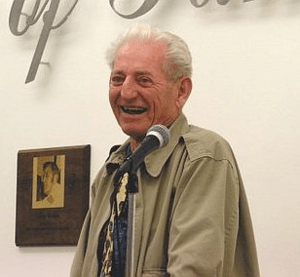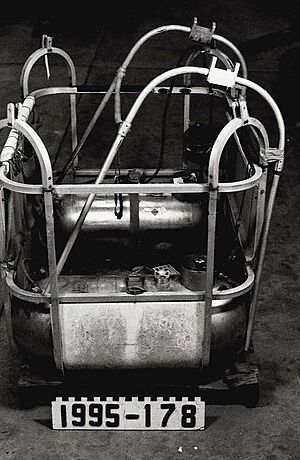Ed Yost facts for kids
Quick facts for kids
Ed Yost
|
|
|---|---|
 |
|
| Born |
Paul Edward Yost
June 30, 1919 Bristow, Iowa, US
|
| Died | May 27, 2007 (aged 87) |
| Occupation | Inventor |
| Employer | Raven Industries General Mills |
| Known for | Ballooning |
|
Notable work
|
Inventor of the modern hot air balloon |
Paul Edward Yost (born June 30, 1919 – died May 27, 2007) was an American inventor. He is known as the "Father of the Modern Day Hot-Air Balloon."
Yost worked for a research division of General Mills in the early 1950s. This division studied high-altitude flight. In 1956, he left General Mills to start his own company, Raven Industries. He founded it with several co-workers.
Contents
Who Was Ed Yost?
Paul Edward Yost was born on a farm in Bristow, Iowa. He first got involved with balloons when he rented his plane to General Mills. They used his plane to follow their gas balloons. Soon, he became a senior engineer. He helped develop balloons for high-altitude research.
Bringing Back Hot Air Balloons
In the 1950s, Yost became very interested in hot air balloons. Manned hot air ballooning had been invented in France in the late 1700s. The Montgolfier brothers were pioneers in this field.
However, their balloons were heated by a fire on the ground. This made flights dangerous. The practice was stopped when hydrogen and later helium became available for balloons.
Yost's Big Idea
Yost had a brilliant idea: a hot air balloon could carry its own fuel! He realized that light burners fueled by propane could reheat the air. This meant balloons could fly for much longer.
His invention made modern hot air balloons much safer and easier to control. Yost also patented many improvements. These included special nonporous fabrics and systems for steering and landing. He also designed the famous "teardrop" shape of the balloon itself.
Ed Yost the Aviator
In October 1955, Yost built and flew the first modern hot air balloon prototype. It was a tethered flight, meaning it was tied down. The balloon was made of plastic film, and kerosene provided the heat. This first flight helped him find and fix problems with his design.
Founding Raven Industries
Raven Industries became a leader in making hot air balloons. Paul Edward Yost and his colleagues founded Raven in 1956. The US Navy's Office of Naval Research (ONR) hired Raven. They wanted a reusable, lightweight balloon that could carry a pilot to 10,000 feet for three hours.
Yost made his first tethered flight in October 1955. He used plastic film from gas balloons and heat from plumber's pots burning kerosene. He stayed in the air for 25 minutes and traveled three miles.
First Free Flight
On October 22, 1960, Yost made history. He took off from Bruning, Nebraska, in the first-ever free flight of a modern hot air balloon. His balloon flew without being tied down for 1 hour and 35 minutes. It used heat from a propane burner.
The balloon's 40-foot-wide fabric was specially chosen by Yost. In November 1960, Yost made a second flight. This improved balloon launched from the famous Stratobowl in Rapid City, South Dakota.
A New Sport Begins
Raven Industries sold its first civilian hot air balloon in November 1961. This helped start a new sport! The Raven Vulcoon balloon was the first hot air balloon to get an airworthiness certificate. This certificate came from the Federal Aviation Administration.
This specific balloon, N1960R, was made in May 1972. It first flew on June 11 of that year. It could hold 56,500 cubic feet of air. It weighed 325 pounds empty and could lift up to 1400 pounds.
Crossing the English Channel
On April 13, 1963, Yost made another big flight. After making more improvements, he piloted the first modern hot air balloon across the English Channel. He flew with fellow balloonist Don Piccard in a balloon called the “Channel Champ.”
Atlantic Ocean Attempt
In 1976, Yost tried to cross the Atlantic Ocean by himself in a balloon. He set 13 aviation world records for distance and time in the air. He designed and built his balloon, the “Silver Fox,” partly in his home garage.
The gondola (the basket) was shaped like a boat. This was in case he landed in the sea, which is exactly what happened. He traveled far enough to reach Europe, but his path turned south instead of east. This was due to wrong weather forecasts. The dream of crossing the Atlantic was achieved two years later. Yost helped with the project, and the balloon, Double Eagle II, was built with his designs.
Promoting Ballooning
Yost also helped grow the sport of ballooning. He helped create the Balloon Federation of America (BFA). He also helped organize the first U.S. National Ballooning Championship in Indianola, Iowa.
In 2002, Yost founded the Balloon Historical Society (BHS). On July 28, 2004, the BHS dedicated four monuments. These monuments were placed on the rim of the Stratobowl. They remember the important balloon projects from the 1930s and Yost's second modern hot air balloon flight.
Later Life
Paul Edward Yost passed away on May 27, 2007. He was 87 years old and died of a heart attack at his home in Vadito, New Mexico, near Taos, New Mexico. He was buried in the Allison cemetery in Allison, Iowa.
Images for kids



